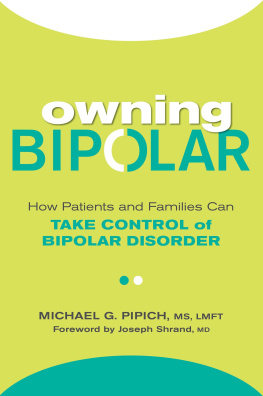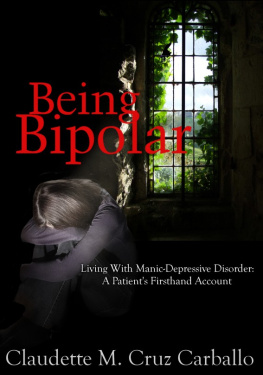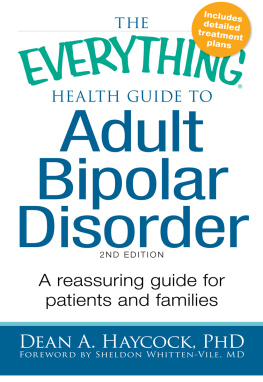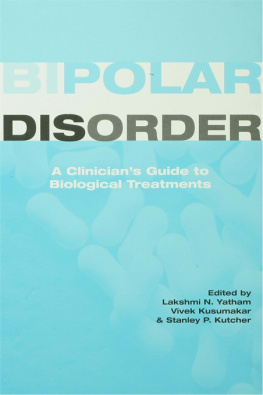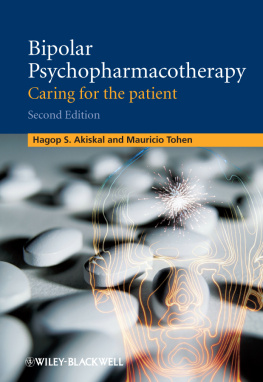Enhance Your Highs, Boost Your
Creativity and Escape the Cycles
of Recurrent Depression
BIPOLAR II
The Essential Guide to Recognize
and Treat the Mood Swings of This
Increasingly Common Disorder
RONALD R. FIEVE, MD

Notice
The names and identifying characteristics of the patients discussed in this book have been changed to protect their privacy.
This book is intended as a reference volume only, not as a medical manual. The information given here is designed to help you make informed decisions about your mental health. It is not intended as a substitute for any treatment that may have been prescribed by your doctor. If you suspect that you have a medical problem, we urge you to seek competent medical help.
Mention of specific companies, organizations, or authorities in this book does not imply endorsement by the publisher, nor does mention of specific companies, organizations, or authorities imply that they endorse this book.
Internet addresses and telephone numbers given in this book were accurate at the time it went to press.
All rights reserved. No part of this publication may be reproduced or transmitted in any form or by any means, electronic or mechanical, including photocopying, recording, or any other information storage and retrieval system, without the written permission of the publisher.
Rodale books may be purchased for business or promotional use or for special sales. For information, please write to:
Special Markets Department, Rodale, Inc., 733 Third Avenue, New York, NY 10017
The following excerpts from the Diagnostic and Statistical Manual of Mental Disorders: , copyright 2000, reprinted with permission by the American Psychiatric Association.
Book design by Christina Gaugler
Library of Congress Cataloging-in-Publication Data
Fieve, Ronald R.
Bipolar II : enhance your highs, boost your creativity and escape the cycles of recurrent depression : the essential guide to recognize and treat the mood swings of this increasingly common disorder / by Ronald Fieve.
p. cm.
Includes bibliographical references.
eISBN-13 9781605296210 ebook
ISBN-13 9781594862243 hardcover
ISBN-10 1594862249 hardcover
1. Manic-depressive illnessPopular works. 2. Manic-depressive illnessTreatmentPopular works. I. Title.
RC516.F44 2006
616.89'5dc22 2006014510

We inspire and enable people to improve
their lives and the world around them
For more of our products visit RodaleWellness.com
To the countless volunteer patients who made the
clinical research and development of new
anti-depressive and bipolar medications possible.
To my professional staff at Fieve Clinical Services
in New York City who continue to conduct
these new investigational drug trials.
CONTENTS
PREFACE
M ost people who will read this book think they are depressed. And most likely they are, have been, or have a close relative or friend who is.
The bigger question in this book is whether the depression they feel is part of a lesser-known, more complicated disorder known as bipolar disorder. For the past 30 years, I have focused my academic research exclusively on the diagnosis and treatment of this disorder, including identifying subtypes and new medications that can effectively stabilize mood without sacrificing quality of life.
In 1971, when I was chief of psychiatric research in manic-depressive disorders at Columbia Presbyterian Medical Center and the New York State Psychiatric Institute, I first observed creative, productive manic-depressive patients. These mild manic-depressives, who, at the time, had no specific diagnostic label, were all lumped into the century-old manic-depressive category, which included people who were permanently hospitalized or even institutionalized for years, suffering psychotic highs and lows for which there was little treatment. Yet these patients had never been hospitalized for mania and were undoubtedly the superachievers in New York City in almost all fields. They would agree to come to my office only when in their depressed phases, resisting any form of treatment for their normal or productive highs. I concluded that the common denominator that linked these achievers was their mild highs, as they never experienced psychotic mania. We now know that these mild manic-depressive achievers had what we today call Bipolar II, the subject of this book.
On June 25, 1973, this idea was featured in the New York Times front-page story entitled AMA Speaker Declares Manic Phase Helps Gifted. The article reported to the worldwide readership my original concept: The milder form of manic depressionat the time still not labeled as Bipolar IItremendously helps the gifted and demands different treatment from that given to the overall group of manic-depressives in order to prevent their creativity from being dampened.
Early in my career I was credited by colleagues as the American pioneer in the use of lithium for manic depression. In 1975, I wrote Moodswing, which sold more than 1 million copies in five editions (English, German, Spanish, UK, and French). It was to become the most comprehensive book on manic depression for the layperson and the first one to announce to a popular audience the effectiveness of lithium in the treatment of all forms of bipolar mood swings, which were still lumped together as manic depression. The manic-depressive disorder that I wrote about in Moodswing is now referred to as Bipolar I. One year later in 1976 at the National Institute of Mental Health, a young research psychiatrist in training, Dr. David Dunner, was the first to identify this milder form of mood swing that I had been observing in my patients, and he labeled this group Bipolar II. His research showed that genetic, clinical, and biochemical factors in Bipolar II disorder patients were different from those in Bipolar I. Shortly after, Dr. Dunner joined me at Columbia Presbyterian Medical Center/New York State Psychiatric Institute, where together we carried out some of our most important research on lithium and bipolar illness.
From the thousands of patients I have treated since the early 1970s, along with the major diagnostic changes of manic depression, I concluded that about half of my Bipolar II patients used their mild hypomanic highs to an advantage. I labeled this group of gifted people as Bipolar IIB (beneficial) and published a medical journal study on this topic in 1992.
Since then, I have learned so much more about what keeps patients feeling in top form and living highly productive lives. Throughout this book, I want to help you recognize the earliest signs of this increasingly diagnosed soft condition, Bipolar II, and teach you how to be proactive in preventing debilitating episodes. I want you and your family to see how early recognition of the signs and symptoms of mild to severe depression and hypomania (mild mania) will improve the prognosis for Bipolar II, so you can see your doctor immediately for effective treatment. Above all, I want to help you prevent the tormenting high and low moods that often arise with Bipolar II disorder. And with proper treatment and maintenance, you will be able to prevent them.


